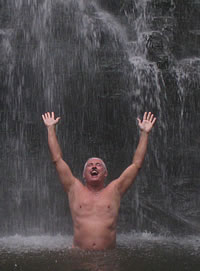Driving A Trance State
So how does one enter trance states? With practice, they can be willed. But there are external practices which can facilitate these states. One of the most common methods used by Neopagans today is through sonic driving. But there are many other forms of "driving" a trance state, and all have been in use for eons. All the senses can participate here, hearing, feeling (including movement), seeing, smelling, etc. Some can be more effective (for me, at least) than others. But often these techniques can be combined to great effect.
Here repetitive, rhythmic stimuli are used to cause trance. Some call this auditory driving. Drumming is one of the most common practices. Modern dance music, played loud, can also have the same effect, as anyone who has ever frequented dance clubs can tell you.
Ancient shamans used drumming to help them cross into the Otherworlds on their errands of healing. Modern shamanic practice still uses drums. Michael Harner's Core Shamanism practice requires the use of drums, either live or on tape. Anthropologist Felicitas Goodman also discovered that drumming was effective in allowing her various 'postures' to work for spiritual purposes. Other forms of sonic driving include chanting and singing.
I used to call this 'movement' but have taken the clinical name now because it can involve so much more than that. Dance is one of the primary forms of kinesthetic driving, used by Pagans everywhere. One famous Islamic sect, the Sufi's, have a well known branch called the 'Whirling Dervishes' who use dance as a 'remembrance of God' creating ecstatic trance states. (see photos here). Other forms include yoga and breathwork (counting the breaths, for example), and here I would also place my primal, body-stress ecstatic practices.
Note: ADF neither promotes nor recommends these practices.
As the name implies, these practices involve stressing the body in some way to create altered consciousness. Techniques include flagellation, self mortification, piercing, fasting (from food or sex), sleep deprivation, cold or heat, etc. In Medieval Europe, following the Black Death, groups of people started wandering around, beating themselves bloody, reaching ecstatic states, and preaching against the immorality of the clergy. Medieval (and nearly modern) saints used many of these practices to reach God. Modern Hindus participate in religious rites such as the Kavadi, where harnesses are worn to hold sharpened sticks or spears into the worshipper's flesh. North American native tribes used (and still use today) body-stress practices for religious reasons, one famous example being the Sun Dance of the plains peoples. Here, the men have eagle claws (or wooden pegs) inserted into the flesh of their chests. Ropes or thongs are tied to the claws at one end and then to a post or pole, and the worshipper leans back, pulling on the claws in his flesh until the skin rips and the claws break free. This process can last days and produces a very deep ecstatic trance state. Modern Primitives have been known to suspend themselves from the ceiling, attached to ropes through hooks in their flesh. While I have experienced some of these extremely powerful techniques, I don't recommend them unless they are performed under the watchful eyes of experienced practitioners. They can be very dangerous and are only for adults.
 druidkirk.org
druidkirk.org
 Body-stress Practices
Body-stress Practices